POSSIBLE INFLUENCE OF THE

Go to Table of Contents of the analysis (which has also a statement on purpose and manner of analysis and a disclaimer as to caveat emptor and my knowing anything authoritatively, which I do not, but I do try to not know earnestly, with some discretion, and considerable thought).
Kubrick based Eyes Wide Shut on Arthur Schnitzler's Traumnovelle (Dream Story). I read that he purchased the rights to the novel via Jay Cocks or Jan Harlan, the years given on the internet being uncertain, as is the "via" uncertain, this sometimes occurring in 1968, 1970, or 1971. Wolfgang Gluck, in 1969, made a TV film of the book, this movie also titiled Traumnovelle, so the purchase would seem likely to have occurred after Gluck's film.
I rarely check out Reddit, but yesterday I fortunately followed a link to the Kubrick film section and thus learned that Gluck's film is now online. So, thanks Reddit! I'd not have known otherwise, and having now watched the film I can see how it serves in many respects as an important bridge between Schnitzler's book and Kubrick's realization of it.
What was an especial surprise to me was the prospect that Gluck's Traumnovelle may have influenced The Shining, which I'll write about today and save my observations on its influence on Eyes Wide Shut for another post or posts.
Even more surprising was how in light of Gluck's Traumnovelle, links can be possibly posited between it, The Shining and Vivian Kubrick's The Making of the Shining, things which I'd already noted beforehand but seem even clearer due a couple of images in particular that appear to have been borrowed by Kubrick from Traumnovelle.
In Gluck's Traumnovelle, after Fridolin (Kubrick's Bill) visits Marianne and the death bed of her father, as he makes his exit he stops beneath the dead man's window. In the book we have the following:
Outside the door to the apartment block, Fridolin looked up at the window he himself had opened earlier, the frames were quivering slightly in the wind that gave a foretaste of spring. The people who had remained behind up there, the living no less than the dead, appeared equally ghostly and unreal to him. It seemed as if he had escaped, not so much from an experience as from some melancholy enchantment that must not gain power over him.
Gluck pictures the scene in the below manner, Fridolin remarking on the ghostliness. We see in the window a green hue that Kubrick uses repeatedly in The Shining and which is also in The Making of The Shining.
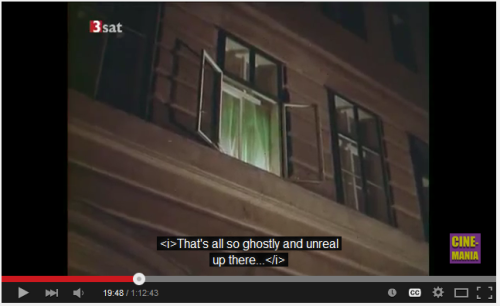
The green, not due fluorescent lamps in Gluck's film, is instead supposedly caused by a scarf thrown over a lamp that we observed previously in the room of the dead man. But when one is in the room, the effect seems not so observable as to cast the window in the deep greenish hue we observe from the outside, which has been remarked upon as being "ghostly".

If we back up to before Fridolin enters the apartment of the dead man, yet again we see this strong green even through the crack of the barely open door.
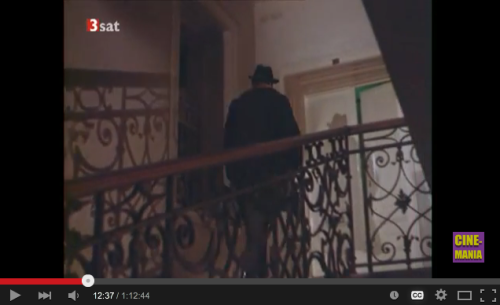
When Fridolin steps through this door into an entry hall the green isn't observed, and he must pass then through yet another barely open door into the room of the dead man. So, this green effect as observed through the front door and window is one that was a very intentional special effect.
The Traumnovelle film is not only concerned with the porous line between reality and dreams, but plays with Fridolin entering the underworld via a hearse that he follows later to a masked ball, and in which he is forced to ride when he is expelled from the party after having been "redeemed" by a mysterious woman. Traveling in the hearse, after the party, brings upon him such a panic that he feels himself dead and fights the walls as if he is battling the walls of a coffin.
Again, a similar green hue is associated with death when Fridolin visits the body of his supposed redeemer in the morgue.
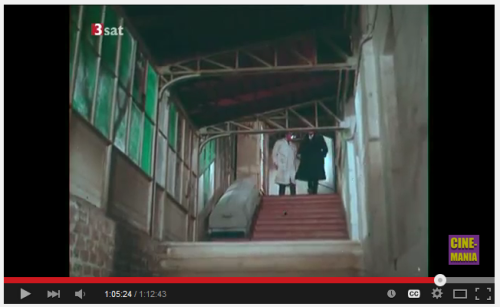
Fridolin's redeemer is the only woman at the masked ball who wears green.

Let's go now to Vivian Kubrick's The Making of The Shining. It opens with a pan across the outer brick wall of the studio, stopping on these rooms. It would seem that we already see the bathroom of room 237 being referenced, and the green of the stairwell on the second floor located next room 237. Was Gluck's Traumnovelle an influence?

After this opening shot, Vivian moves to the inside, entering the room that possesses the two large left windows, and we know this is that room as the pitcher and vase we can see from the outside are viewed on the inside window sill. Jack is ordering a meal with rice or noodles and Vivian is teased that she could have been walking in on personal business. Jack then tucks in his shirt and we see on the wall in the background a black mask. Though it is a cat mask, it is in the style of mask that is worn by the men at the masked ball in Gluck's Traumnovelle, they all having plain black partial masks whereas the women at the party wear more ornamental partial masks of different colors. We see through the door behind Jack the room from which the green fluorescent light spills in the far right window in the image above (the two windows between are bathroom windows, the bathroom stopping short of the door behind Jack).
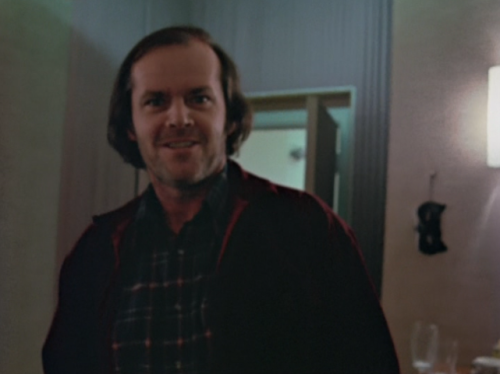
In Gluck's Traumnovelle the mansion at which the masked ball takes place has two seeming female sphinxes outside the main entry, which are perhaps also alluded to in the choice of the mask behind Jack being a cat mask, and if this is so one has to wonder about Clockwork Orange and the two female sphinxes outside the mansion of the cat woman who is wearing a green leotard when murdered by Alex. There are even more associations to be made, such as the cat woman keeps a health spa in which we view a lot of exercise equipment, and in the fluorescent-lit room behind Jack there are weights for weight training on the floor.
Vivian follows Jack into the bathroom past a big bowl of vitamins. First she focuses on a green towel on the bathroom floor. Above it is a white towel then a deep yellow one, different in tone but very near the color combo we'll see again in the bathroom of room 237. In the bathroom mirror, she films herself filming Jack as he makes a big production of brushing his teeth, after which he shoos her out in a claim for some privacy.
The first whiff of this green of the ghostly window in Traumnovelle that we get in The Shining is when Danny is in the bathroom after brushing his teeth and immediately before he has his first vision. It's a crossfade from Jack at his interview, so the green shines over Jack
Not that the first use of green associated with the paranormal or the ghostly was in Gluck's Truamnovelle, for that's not the case. Green has long been used along with the weird. But Kubrick was preparing for Eyes Wide Shut long before he filmed it, and it stands to reason that Traumnovelle may have had an influence on his earlier work. For instance, the yellow VW carrying up to the Overlook far more luggage than it could have held seems to have been inspired by the book, Traumnovelle, and a dream Albertine had of a yellow bag that was able to contain virtually everything that was put into it.

The service halls of the Overlook Hotel are green, but the principle use of green that most strongly connects to the green window of the dead man in Gluck's Traumnovelle and Vivian's The Making of the Shining are the three below.
Danny's first trip through the room 237 hallway shows the doors to the stair open.

Danny's second scene in that hallway, in which he approaches the open door of room 237, has the stairway doors closed, and the fluorescent green light in the windows has an emphatic, eerie presence.

Finally, there's the green bathroom of room 237. Once we see the green bathroom, the green light in the windows of the stairwell seems connected with it. One has even a sense of curious attentiveness in the green windows of the service stairway before Danny approaches room 237.

We might see in the green tub, the white shower curtain, and the yellow-orange arch, a color combination very near the green, white and yellow towels observed in Jack's bathroom at the beginning of The Making of The Shining.
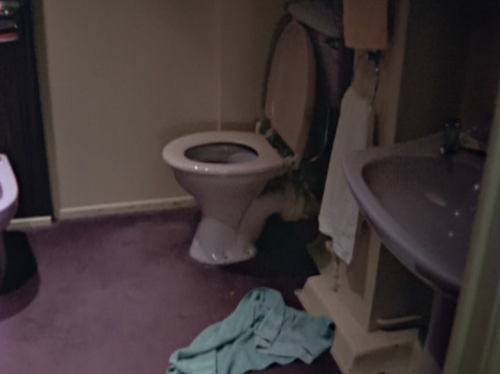
The woman in the bathroom in the book of The Shining is supposed to have committed suicide. And the redeeming woman in Traumnovelle is claimed to have committed suicide by morphine.
So, why the focus upon the green window in The Making of The Shining and the glimpse of the mask? It's always possible these bits may be purely coincidence. But what if they're not? It's a film of the making of a film, and as best as I can tell it's perhaps another expression of the porous wall between reality and dream, the sometimes porous wall between reality and fiction (such as how documentary is also a construct of the vision of the filmmakers). What is reality as versus the mask of everyone's daily fictions set forth as their true selves? In Traumnovelle, after the scare of the masked ball, Fridolin insists to himself that he will from now on show his true face, tearing off his mask, but then Fridolin's wife later exposes him as still wearing a mask when she leaves the mask on his pillow. But I'll write more about that in another post on how Traumnovelle works with masks in comparison to Eyes Wide Shut. For what often escapes is how we have in Eyes Wide Shut, as well as Traumnovelle, the masks that separate the sacred from the secular.
Originally published on Tumblr April of 2015.
March 2016 moved to html from Tumblr post placed about 2014-2015. Approx 1686 words or 3 and 1/2 single-spaced pages. A 13 minute read at 130 wpm.
Return to Table of Contents for "The Shining" analysis
Return to Table of Contents for "Eyes Wide Shut" analysis
Link to the main Kubrick page for all the analyses

